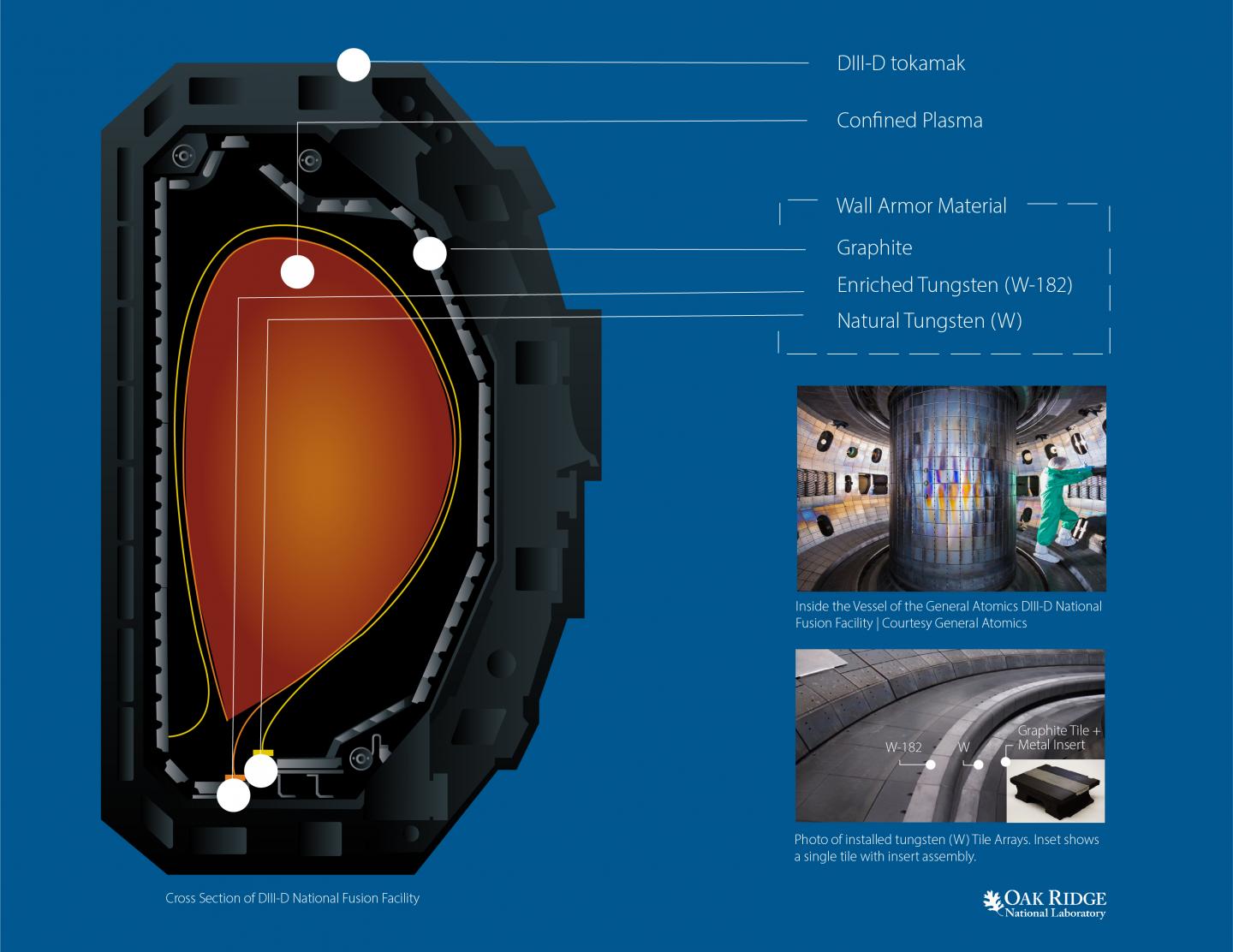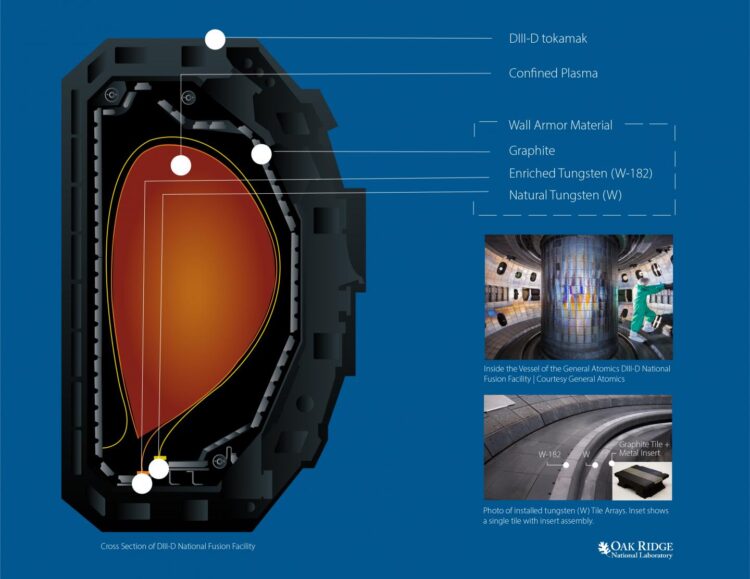
Credit: Jaimee Janiga/ORNL
The inside of future nuclear fusion energy reactors will be among the harshest environments ever produced on Earth. What’s strong enough to protect the inside of a fusion reactor from plasma-produced heat fluxes akin to space shuttles reentering Earth’s atmosphere?
Zeke Unterberg and his team at the Department of Energy’s Oak Ridge National Laboratory are currently working with the leading candidate: tungsten, which has the highest melting point and lowest vapor pressure of all metals on the periodic table, as well as very high tensile strength — properties that make it well-suited to take abuse for long periods of time. They’re focused on understanding how tungsten would work inside a fusion reactor, a device that heats light atoms to temperatures hotter than the sun’s core so that they fuse and release energy. Hydrogen gas in a fusion reactor is converted into hydrogen plasma — a state of matter that consists of partially ionized gas–that is then confined in a small region by strong magnetic fields or lasers.
“You don’t want to put something in your reactor that only lasts a couple of days,” said Unterberg, a senior research scientist in ORNL’s Fusion Energy Division. “You want to have sufficient lifetime. We put tungsten in areas where we anticipate there will be very high plasma bombardment.”
In 2016, Unterberg and the team began conducting experiments in the tokamak, a fusion reactor that uses magnetic-fields to contain a ring of plasma, at the DIII-D National Fusion Facility, a DOE Office of Science user facility in San Diego. They wanted to know whether tungsten could be used to armor the tokamak’s vacuum chamber — protecting it from rapid destruction caused by the effects of plasma — without heavily contaminating the plasma itself. This contamination, if not sufficiently managed, could ultimately extinguish the fusion reaction.
“We were trying to determine what areas in the chamber would be particularly bad: where the tungsten was most likely to generate impurities that can contaminate the plasma,” Unterberg said.
To find that, the researchers used an enriched isotope of tungsten, W-182, along with the unmodified isotope, to trace the erosion, transport and redeposition of tungsten from within the divertor. Looking at the movement of tungsten within the divertor — an area within the vacuum chamber designed to divert plasma and impurities — gave them a clearer picture of how it erodes from surfaces within the tokamak and interacts with the plasma. The enriched tungsten isotope has the same physical and chemical properties as regular tungsten. The experiments at DIII-D used small metal inserts coated with the enriched isotope placed close to, but not at, the highest heat flux zone, an area in the vessel typically called the divertor far-target region. Separately, at a divertor region with the highest fluxes, the strike-point, researchers used inserts with the unmodified isotope. The remainder of the DIII-D chamber is armored with graphite.
This setup allowed the researchers to collect samples on special probes temporarily inserted in the chamber for measuring impurity flow to and from the vessel armor, which could give them a more precise idea of where the tungsten that had leaked away from the divertor into the chamber had originated.
“Using the enriched isotope gave us a unique fingerprint,” Unterberg said.
It was the first such experiment conducted in a fusion device. One goal was to determine the best materials and location for these materials for chamber armoring, while keeping impurities caused by plasma-material interactions largely contained to the divertor and not contaminating the magnet-confined core plasma used to produce fusion.
One complication with the design and operation of divertors is impurity contamination in the plasma caused by edge-localized modes, or ELMs. Some of these fast, high-energy events, akin to solar flares, can damage or destroy vessel components such as divertor plates. The frequency of the ELMs, the times per second these events occur, is an indicator of the amount of energy released from the plasma to the wall. High-frequency ELMs can release low amounts of plasma per eruption, but if the ELMs are less frequent, the plasma and energy released per eruption is high, with a greater probability for damage. Recent research has looked at ways to control and increase the frequency of ELMs, such as with pellet injection or additional magnetic fields at very small magnitudes.
Unterberg’s team found, as they expected, that having the tungsten far from the high-flux strike-point greatly increased the probability of contamination when exposed to low-frequency ELMs that have higher energy content and surface contact per event. Additionally, the team found that this divertor far-target region was more prone to contamination the SOL even though it generally has lower fluxes than the strike-point. These seemingly counterintuitive results are being confirmed by ongoing divertor modeling efforts in relation to this project and future experiments on DIII-D.
This project involved a team of experts from across North America, including collaborators from Princeton Plasma Physics Laboratory, Lawrence Livermore National Laboratory, Sandia National Laboratories, ORNL, General Atomics, Auburn University, the University of California at San Diego, the University of Toronto, the University of Tennessee–Knoxville, and the University of Wisconsin-Madison, as it provided a significant tool for plasma-material interaction research. DOE’s Office of Science (Fusion Energy Sciences) provided support for the study.
The team published research online earlier this year in the journal Nuclear Fusion.
The research could immediately benefit the Joint European Torus, or JET, and ITER, now under construction in Cadarache, France, both of which use tungsten armor for the divertor.
“But we’re looking at things beyond ITER and JET — we’re looking at the fusion reactors of the future,” Unterberg said. “Where is it best to put tungsten, and where should you not put tungsten? Our ultimate goal is to armor our fusion reactors, when they come, in a smart way.”
Unterberg said ORNL’s unique Stable Isotopes Group, which developed and tested the enriched isotope coating before putting it in a form useful for the experiment, made the research possible. That isotope would not have been available anywhere but from the National Isotope Development Center at ORNL, which maintains a stockpile of almost every element isotopically separated, he said.
“ORNL has unique expertise and particular desires for this type of research,” Unterberg said. “We have a long legacy of developing isotopes and using those in all kinds of research in different applications around the world.”
In addition, ORNL manages US ITER.
Next, the team will look at how putting tungsten into differently shaped divertors might affect contamination of the core. Different divertor geometries could minimize the effects of plasma-material interactions on the core plasma, they have theorized. Knowing the best shape for a divertor — a necessary component for a magnetic-confined plasma device — would put scientists one step closer to a viable plasma reactor.
“If we, as a society, say we want nuclear energy to happen, and we want to move to the next stage,” Unterberg said, “fusion would be the holy grail.”
UT-Battelle manages ORNL for the Department of Energy’s Office of Science, the single largest supporter of basic research in the physical sciences in the United States. The Office of Science is working to address some of the most pressing challenges of our time. For more information, please visit energy.gov/science.
Media Contact
Kristi Nelson Bumpus
[email protected]
Original Source
https:/
Related Journal Article
http://dx.





